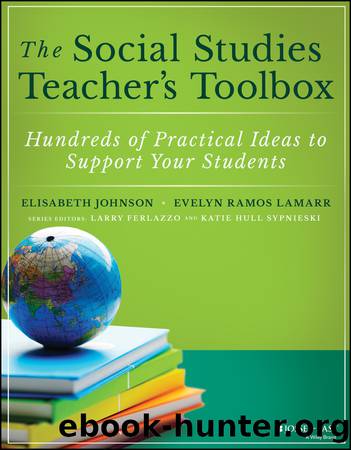The Social Studies Teacher's Toolbox: Hundreds of Practical Ideas to Support Your Students by unknow

Author:unknow
Language: eng
Format: epub
Publisher: John Wiley & Sons, Incorporated
Published: 2020-04-28T00:00:00+00:00
IN-DEPTH ANALYSIS OF SOURCE
While the previous strategy provided a cursory overview of the document, students have yet to analyze the content in any depth. We continue the study of Hernán Cortés' letter describing the Aztec city of Tenochtitlan as soon as we complete Figure 13.1: At a Glance Analysis of Source.
It is helpful to provide students with historical context prior to analyzing a source. In this case, before the analysis of this letter, students have already learned about the general motives of European explorers and conquerors between the 1400s and 1600s. Specifically, they read about Cortés and his role in colonizing what is now Mexico.
We introduce Figure 13.5: In-Depth Analysis of a Written Source by providing copies to students and projecting one on a screen or whiteboard. We explain that we will continue where we left off in the last activity by addressing three themes: identification, message, and motive. These three themes (presented as separate sections on the handout) are inspired by different strategies of primary-source analysis that we have used in the past.
We review the three sections of the handout with students, specifically the guiding questions in the left-hand column, to help students understand what the three themes mean. We explain that Identification is responding to the questions âWhat is it?â âWho created it?â and âWhen was it created?â We go on to say that Message means literally âWhat does it say?â and âWhat does it tell us about the writer and the historical moment?â Finally, we tell students that Motive means âWhy is the person doing this or why is this event happening?â
Before continuing with the reading of the letter, we ask students to consider what they can already answer in the handout. For example, if students have completed Figure 13.1: At a Glance Analysis of Source, it may be helpful to direct them to review it. In this case, we model how to use the notes from this handout to answer most of the first section, Identification, on Figure 13.5: In-Depth Analysis of a Written Source. We write: âThis source is a letter. It was created (written) by Hernán Cortés in 1520.â
Students finish noting any other helpful information from Figure 13.1: At a Glance Analysis of Source. Next, we introduce the following annotation strategies (verbally and in writing) to continue our in-depth analysis:
First, highlight any text that stands out to you in the primary source document and write, in the left margin, why it stood out. Second, label the same text you highlighted, in the right margin, with one of the following section headers that you think the text might connect to: identification, message, or motive.
Download
This site does not store any files on its server. We only index and link to content provided by other sites. Please contact the content providers to delete copyright contents if any and email us, we'll remove relevant links or contents immediately.
| Arts & Humanities | Health |
| Language Arts | Library Skills |
| Mathematics | Reading & Phonics |
| Science & Technology | Social Studies |
The Art of Coaching Workbook by Elena Aguilar(51080)
Trainspotting by Irvine Welsh(21573)
Twilight of the Idols With the Antichrist and Ecce Homo by Friedrich Nietzsche(18571)
Fangirl by Rainbow Rowell(9179)
Periodization Training for Sports by Tudor Bompa(8215)
Change Your Questions, Change Your Life by Marilee Adams(7688)
This Is How You Lose Her by Junot Diaz(6836)
Asking the Right Questions: A Guide to Critical Thinking by M. Neil Browne & Stuart M. Keeley(5709)
Grit by Angela Duckworth(5557)
Red Sparrow by Jason Matthews(5428)
Paper Towns by Green John(5141)
Room 212 by Kate Stewart(5073)
Ken Follett - World without end by Ken Follett(4685)
Housekeeping by Marilynne Robinson(4398)
The Sports Rules Book by Human Kinetics(4347)
Double Down (Diary of a Wimpy Kid Book 11) by Jeff Kinney(4243)
Papillon (English) by Henri Charrière(4229)
The Motorcycle Diaries by Ernesto Che Guevara(4054)
Exercise Technique Manual for Resistance Training by National Strength & Conditioning Association(4023)
